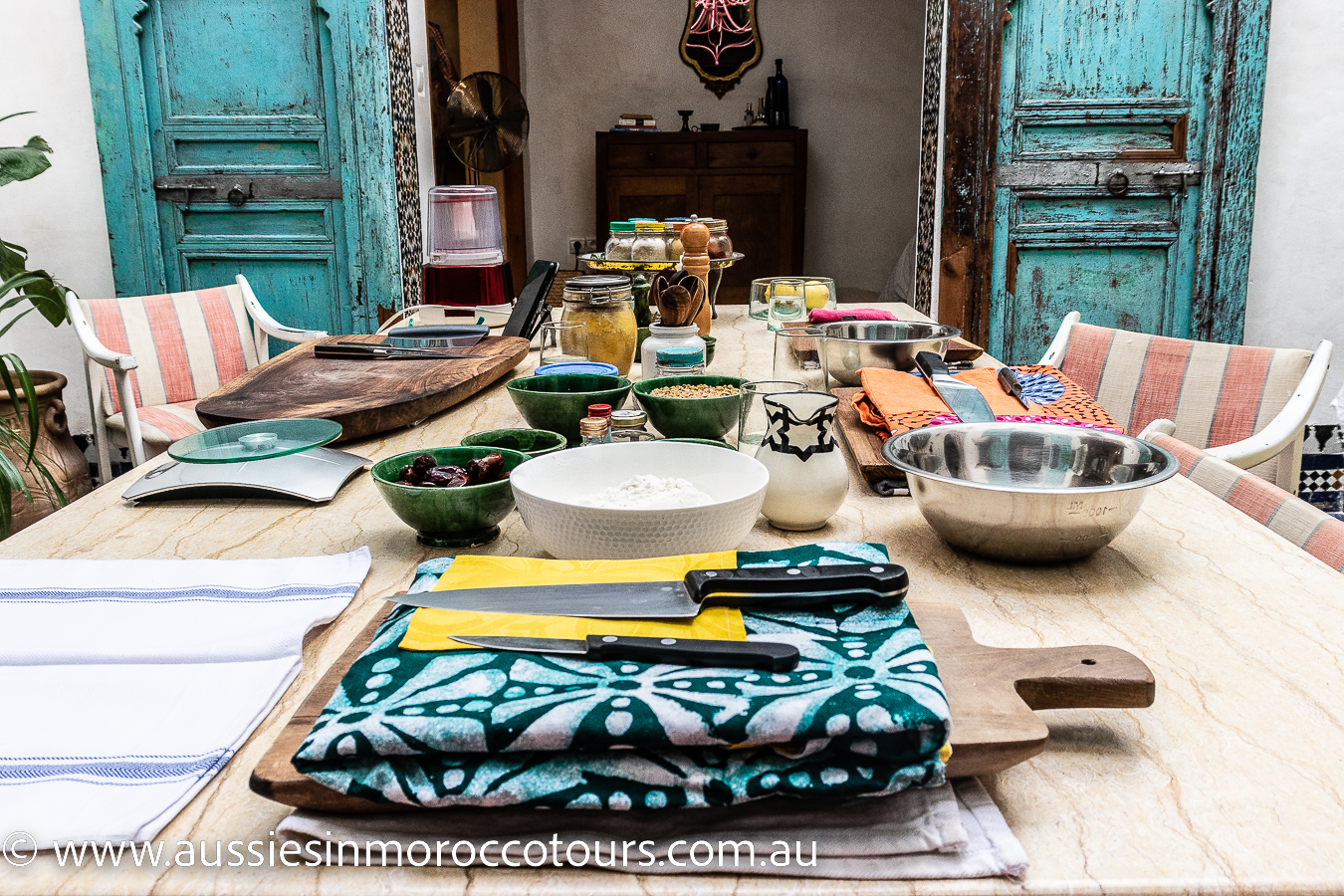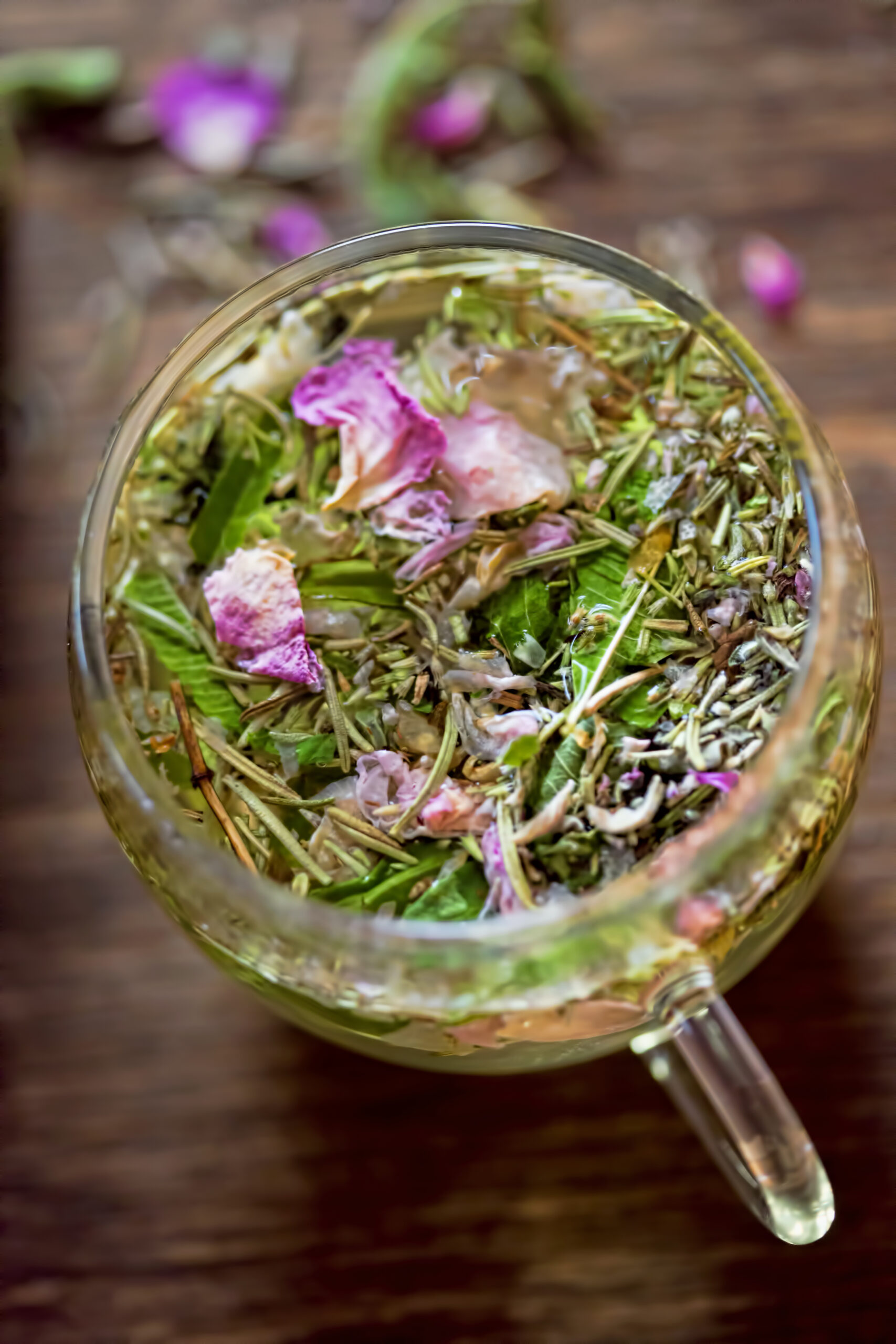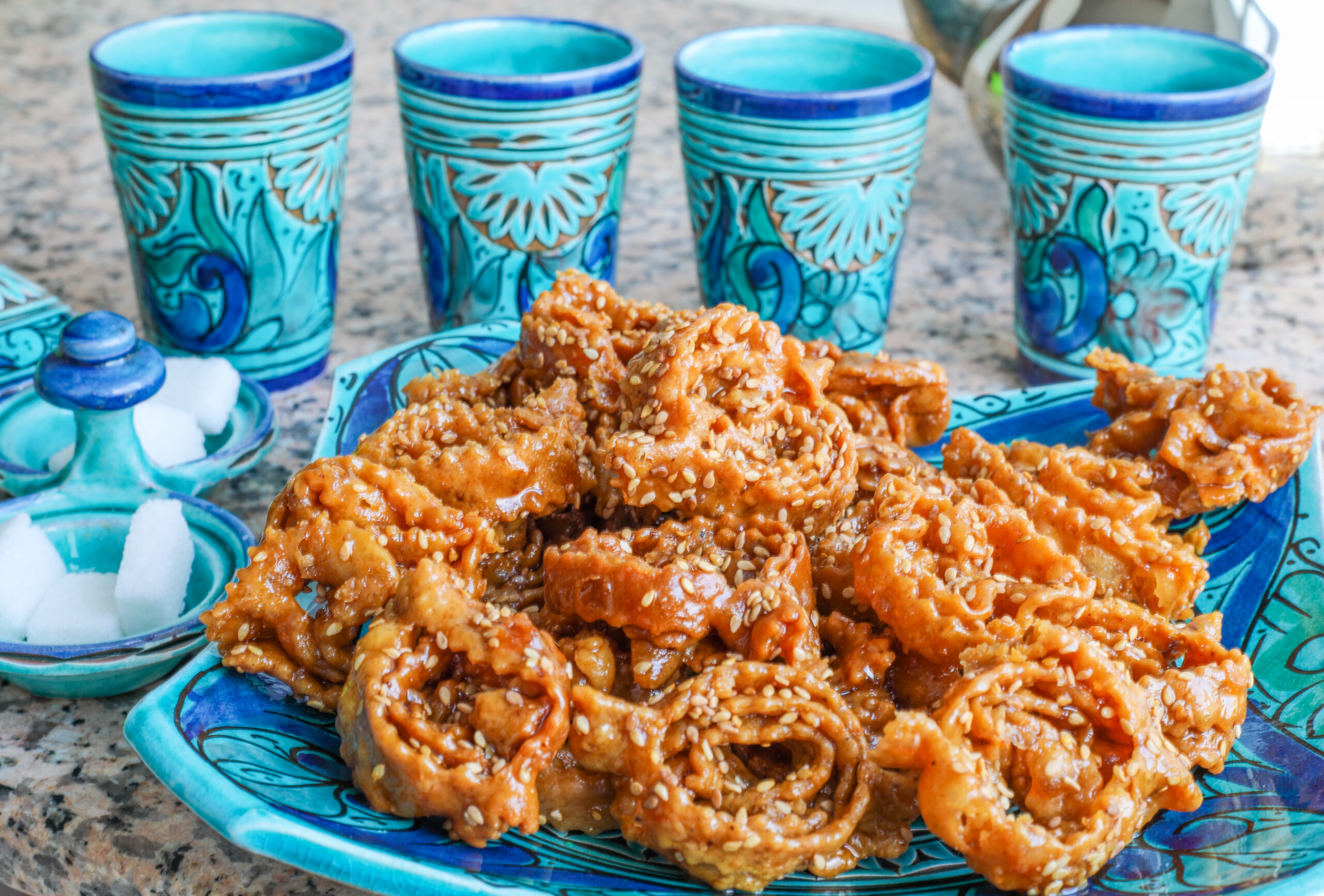
Tara’s kitchen where she works her magic. It is in a 500-year-old Dar.
When I moved to Morocco I first fell in love with the food, then with the power inherent within it. Whenever I got a cold my house manager would whip me up a brew of honey, lemon, cinnamon and olive oil. Something she drinks every day to keep coughs and colds at bay. A spoonful of cumin, eaten raw, was sure to clear up a bad stomach.Also, she assured me, if I drank mint tea infused with rose petals (or better yet, mixed rose water with water from the wedding well found on the beach near the Ouadayas Kasbah in Rabat) I was sure to find a good husband. I realized that here was a culture that valued food as medicine and in some cases, magic, in ways long forgotten in the west.

Nutmeg, mint and rose tea, Moroccan style. We have a map of different tea ingredients for different regions in Morocco, available to clients, together with a facts sheet about them.
The guardians of this knowledge are principally the women of Morocco, and more specifically housewives in rural areas, whose lack of access to modern medicines, healthcare and pharmacies, ensured the spread of an extensive knowledge of plants inherited over millennia from Amazigh, Arab, Sub-Saharan and Jewish peoples. This knowledge occasionally branded them shawafas, or practitioners of witchcraft – a practice that is frowned upon and considered anti-Islamic. Nevertheless, shawafas attract believers in droves, looking for a spell to attract love or cure heartbreak, deliver money, or even offer some form of mental health therapy. More commonly though, these women concocted cures ranging from treating coughs and colds, to more potent libations that tackle anything from diabetes and asthma to physical wounds and disability, eventually migrating into the food on the table.
The earliest culinary culture in Morocco of course was Amazigh, which consisted largely of what we could consider a Mediterranean diet today. Lots of pulses and grains, nuts and seeds, a little meat or fish when available, and the vegetables that grew at the time. The Arabs introduced spices in the 7th century, swiftly followed by the influence of the Jews and the Spanish with fruits and vegetables from the new world, and latterly the French. But it was during the reign of the Almohads who were known for their lavish tastes in medieval Morocco, and which coincided with the Muslim exodus from Moorish Spain, that pushed cooking into the realm of the high arts.
Throughout its long history, Moroccan home cooking was a skill liberally sprinkled with folklore, religious rituals and mysticism, enhanced by deep rooted beliefs in the evil eye and djinns. It was also grounded in health and wellness, and this in turned paved the way for an equally deep-seated belief in the baraka (magical powers) of hospitality. Even today in Morocco, to welcome a guest, is as much an honour for the host as it is for them. In this context, failure to offer food and drink could potentially bring shame on the entire household and indeed, traditionally, when preparing food in wealthier families, an extra portion or two would always be included to ensure enough extra for any unexpected guests.

Selection of spices on a traditional Moroccan market (souk) in Marrakech, Morocco
In Morocco you see, food is deeply entwined with identity: a gift from God to be shared with selfless generosity. Among women, the ability to cook well is a highly esteemed, highly social affair especially for such auspicious occasions as a wedding, where all the female members of the family, as well as half the women in the neighbourhood, pitching in with sprinkles of “this and that” to ensure the happiness, prosperity and fertility of bride and groom. Little surprise then, that many foods are believed to contain magical properties.
One ritual in particular that springs to mind is Ashura, a festival of food, fire and water, that takes place on the 10th day of Muharram, the first month of the Islamic calendar and a time that is said to give women power over men for as long as it lasts.
Cara’s note: A little more detail about Ashura and the food that is consumed to celebrate it in Sunni Morocco in particular, appears here.
Preparations for Ashura begin right after Eid al Adha – the great sacrifice – in which many families slaughter a sheep, and certain parts, such as the tail, are salted, dried in the sun and reserved for a special couscous mixed with herbs and ras al hanout that is said to cure women of sterility (in itself often believed to be the result of a curse by a rival) and bring them a much longed-for child.
Elsewhere the ingredients in your kemia (small appetizers often in the form of a cooked salad), soups, tagines and desserts will have been carefully considered. Garlic is said to ward off the evil eye, in much the same way it’s believed to ward off vampires in Eastern European folklore and is sometimes hung in doorways. Boil it up with lavender and salt and it becomes a potent concoction that will clean the whole house of any such concerns, but also cure a headache. A similar mixture, supplemented with a dried snail and left on your doorstep however, could be a curse.
Any green food like bakoula (stewed, spiced mallow) for example, is said to invite wealth and prosperity, while honey and indeed anything yellow or orange is said to promote a life that is blessedly sweet and trouble free. With that in mind, the turmeric, ginger, cinnamon and cumin used into so many of the country’s most iconic dishes from spicy chermoula fish tagines, fragrant chicken kdras (heady with sweet spices and dried fruits) to lamb mrouzias (an ancient dish typically served for Eid al Adha), take on mythical characteristics befitting of any Arabian night’s fantasy. Turmeric brings the added benefits of being an anti-carcinogen with the potential to ward off Alzheimer’s. Ginger is believed to be effective against nausea, lower blood pressure, relieve arthritis and prevent migraines. Cinnamon is a great mood enhancer, while nigella seeds are a sworn cure for menstrual pain, asthma and auto-immune disorders.

Honey, sesame, cinnamon, saffron, anise & orange flower water are what gives these “moorish” (joke, get it?) flower-shaped biscuits, their sticky-sweet flavour & orange colour.
And then there are the foods that put you in an altered state. Majoun which combines seeds, honey, spices and marijuana to achieve a trance-like state and connect with the spirits, heady mixtures of seeds and spices to improve sexual prowess, flower waters as aphrodisiacs.
Stroll through the Attarine (meaning spice) Souk in Fez today and it’s a kaleidoscope of phone chargers, cables and selfie-sticks, interspersed with herbalists’ stalls selling spices and aromatics. Amongst the dried ginger and turmeric root, dried hibiscus and rose petals, peppercorns and rock salt, you’ll see tortoise shells and lizard skins, fossils and semi-precious stones, all imbued with the power to bring luck or ill fortune, sickness or health, to those who dare to believe.
Just remember: sometimes all you need is the salty-sweet taste of a slow-cooked tagine, or the soothing heft of a seven-vegetable couscous, to assure you all is right in the world.
If you would like to explore mystic Morocco and share a meal with us prepared by Tara with this theme, please read our Magic and Mysticism Tour of Morocco itinerary for April 2024 here.
Alternatively, if you’d like to include one or two of the ideas from our group mysticism tour into your own private one, please let us know.
By Tara Stevens @courtyardkitchenfez, with a minor contribution to content by Cara @aussiesinmoroccotours
Published May 2023
Copyright Tara Stevens in her content herein, exclusively and irrevocably licensed for use throughout the world to Cara Ghassemian trading as/ Aussies In Morocco Tours. All rights reserved, 2023.
